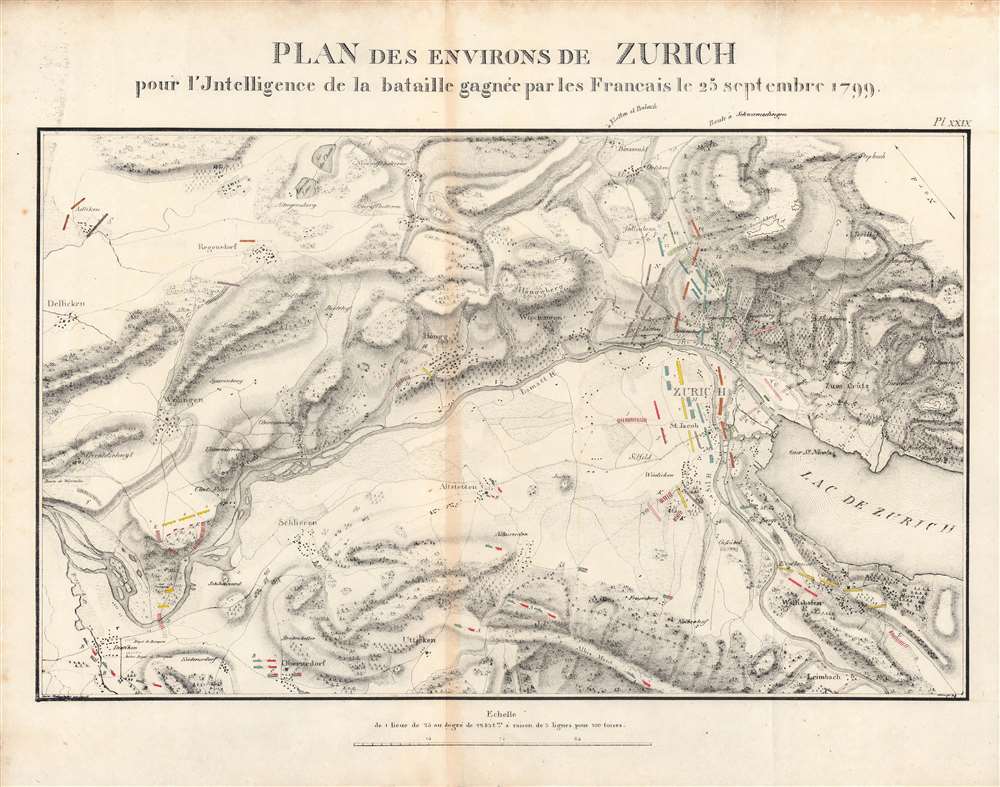This item has been sold, but you can get on the Waitlist to be notified if another example becomes available, or purchase a digital scan.
1839 Jomini Map of the Second Battle of Zurich
SecondBattleZurich-jomini-1839
Title
1839 (undated) 14 x 18.5 in (35.56 x 46.99 cm) 1 : 30000
Description
The Second Battle of Zurich
The Second Battle of Zurich took place on September 25 - 26, 1799, during the War of the Second Coalition, which saw Revolutionary France pitted against Britain, Russia, and Austria. In early June 1799, the French under General André Masséna had been forced to surrender Zurich to the Austrians. Russian troops joined the Austrians after a difficult and circuitous march through the Alps and were tasked with occupying the city.The Russian commander Korsakov was overly confident and unprepared for any French counter-attack, even after his failed attempt to launch a surprise crossing of the Aare River in late August. Instead, he calmly waited for another column of Russian troops under Suvorov marching north from Italy. Seizing the opportunity, Masséna prepared a counterattack, quietly massing his troops at Dietikon (at bottom-left). He faced a significantly smaller Russian force defending the city, and this, along with the benefit of surprise, allowed the French to gain control of both banks of the Limmat River and much of the countryside around the city on the first day of the battle.
They then held off an Austrian column and Russian counter-attacks but would have likely had difficulty taking the city without heavy losses. Nevertheless, Korsakov retreated across the Rhine, and Masséna elected not to pursue the now-demoralized Russian troops but instead turn south and engage Suvorov, who was forced to make a harrowing escape through the Panixer Pass. The recapture of Zurich was a major victory for the French, ensuring control of Switzerland and leading to Russia's pulling out of the Second Coalition, significantly weakening it.
Here, the positions of French troops are shown by bars in the style of the Tricolore. The multiple colors used for Russian forces likely refer to their constituent units, including a Cossack regiment, a grenadier battalion, and squadrons of dragoons.
Publication History and Census
This map appeared as Plate XXIX in Antoine-Henri Jomini and Jean Baptiste Bielaerts' Atlas pour servir à l'intelligence de l'histoire critique et militaire de la révolution, published in Paris in 1839 - 1840 by Libraire Militaire de Petit. It was engraved by Xavier Mettenleiter, while another name (perhaps 'Utimberger') appears at bottom-right, but the individual's role is unclear. It is worth noting that the catalog listing for the Biblioteca Nacional de España lists Richard Wahl as the creator of this map and dates it to 1820, with the same notation as 'Pl. XXIX' (the atlas appears to have been prepared in Brussels in the early 1820s, but publication was delayed until 1839). Aside from the Biblioteca Nacional de España, the map is independently cataloged with the Newberry Library, the Bayerische Staatsbibliothek, and the State Archives of Belgium, while the entire Atlas is held by perhaps twenty institutions in Europe and North America.Cartographer
Antoine-Henri Jomini (March 6, 1779 – March 22, 1869) was a Swiss military officer who became one of the most influential military thinkers of the 19th century. An enthusiastic supporter of the French Revolution and the Helvetic Republic, Jomini quickly rose through the ranks of the republic's military hierarchy before moving to Paris and writing a book titled Traité des grandes operations militaires. Jomini's work caught the attention of Michel Ney, one of Napoleon's leading generals, who brough Jomini onto his staff. Later, due to his research of Frederick the Great's military tactics, Napoleon brought Jomini onto his staff during the War of the Fourth Coalition (1806 – 1807), in which Jomini was highly decorated. Serving for a time in both the French and Russian armies (while they were nominal, uneasy allies after the 1807 Treaty of Tilsit), Jomini was torn when war broke out between the empires in 1812 and tried to avoid field service on either side, leading to his earning enemies among officers of both armies. Still, he accompanied the Russians into Paris and tried unsuccessfully to prevent the execution of Ney. He later attended the Congress of Vienna and lived in Russia, training military officers and advising the Russian military in its battles with the Ottomans. Upon retirement in 1829, he moved to Brussels but returned to advise the Russians during the Crimean War. He advocated all along for greater understanding and cooperation between France and Russia, while also remaining a dedicated Swiss patriot. Jomini's writings were deeply influential on subsequent military thinking, including among the leading generals of the American Civil War, who had studied his works at West Point. Though less famous today, in the 19th century Jomini was seen as an essential accompaniment to Carl von Clausewitz, with whom he had several key points of disagreement. However, both thinkers ultimately concluded that war was more an art than a science, and that unpredictable and unquantifiable factors such as morale and leadership mattered far more than numbers of troops or ammunition. More by this mapmaker...

